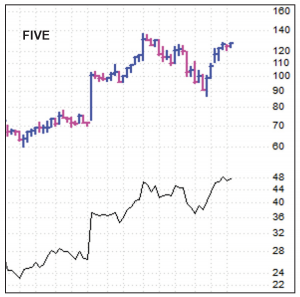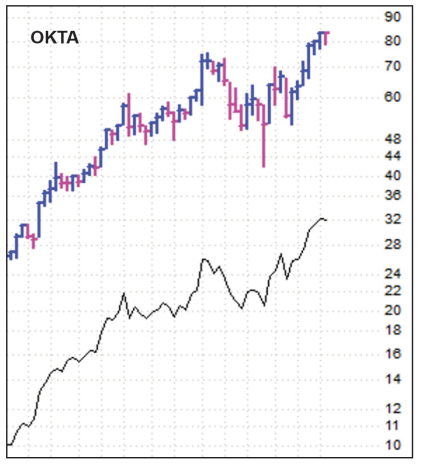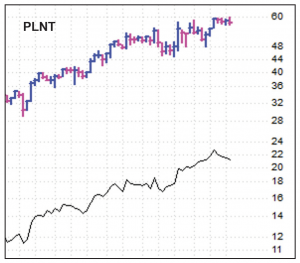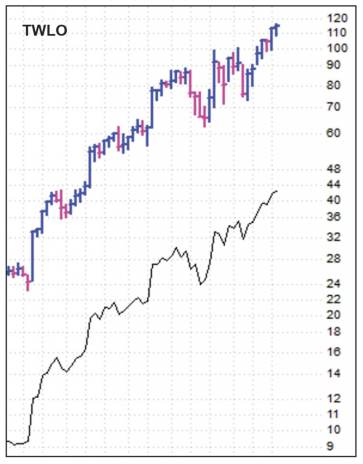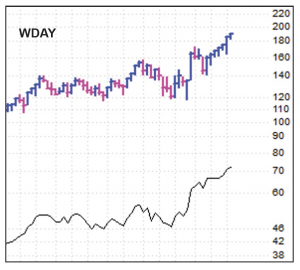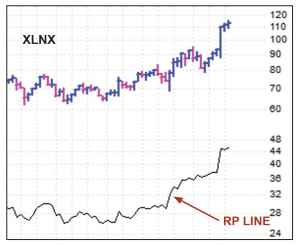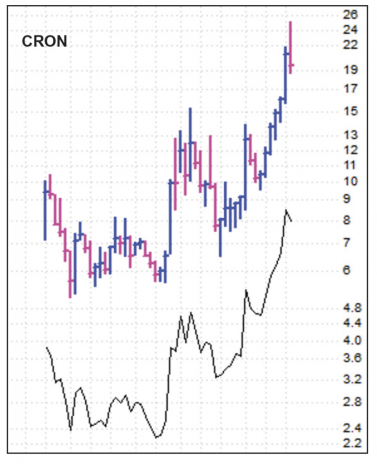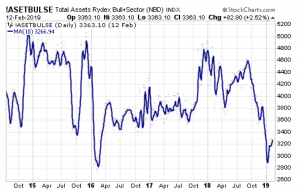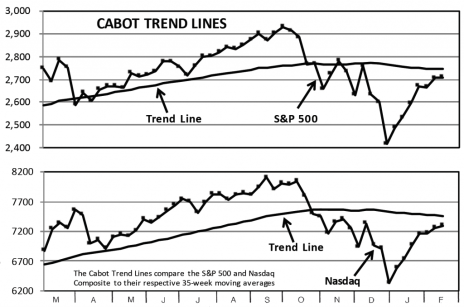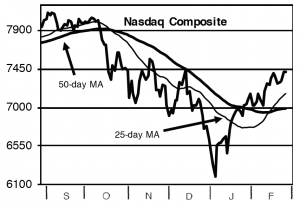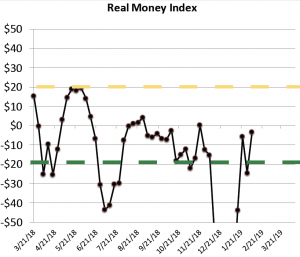The market remains in good shape, generally shrugging off a stream of bad news by marching higher. Pullbacks are certainly possible, but most investors are positioned cautiously, which is another arrow in the bulls’ quiver when looking down the road.
In tonight’s issue, we’re putting another chunk of money to work by adding two half-sized positions (one in a stock we already own). That will leave us with 25% in cash.
Elsewhere in the issue, we write about a couple of additional positive longer-term signs for the market (one based on money flows, one based on the market itself), look at some new ideas and review all of our Model Portfolio holdings.
Cabot Growth Investor 1413
[premium_html_toc post_id="170855"]
It’s Not the News that Counts
One of the biggest banana peels that many investors slip up on is the desire to focus on the news, be it economic reports, high-profile earnings releases or important political rumors (like the current U.S.-China trade talks). But when it comes to investing, the important thing to remember about the news is that it doesn’t count—what really counts is the market’s reaction to the news.
Just this morning, for example, reports surfaced that trade negotiations were deadlocked; initial jobless claims (a key leading economic indicator) lifted to multi-month highs (a bad thing) and December’s retail sales staged their largest decline in nine years! And, more generally, there’s been a big downward revision in earnings estimates for 2019; Wall Street is currently looking for just 4% earnings growth from the S&P 500 this year, and that figure is sliding by the day.
Just going by the news, then, you’d think the market isn’t likely to have a big bull run this year, and could possibly backslide quite a bit. Because of that, most investors are positioned defensively. Indeed, since the market’s December low, money has actually flowed out of equity funds and ETFs (see page 6 for more), and one survey of institutional investors showed them in the most overweight cash position since 2009.
And how is the market handling this news? By ignoring it and going up! Since last year’s low, stocks have levitated higher for eight weeks with hardly any pullbacks at all, bringing more and more evidence to the bull camp. With the intermediate-term trend positive and more longer-term measures pointing up (see page 7), we’re continuing to put money to work.
To be clear, we’re not implying the market can’t finally retreat for a while in the weeks ahead—with our Cabot Trend Lines still negative, it’s still important to look for opportunities and focus on the market’s real leaders. But there’s no question that the bulls are in control today, which means you should be favoring the buy side.
[highlight_box]WHAT TO DO NOW: Continue to put money to work though it’s important to pick your spots (and your stocks). In the Model Portfolio tonight, we’re buying two half-sized (5%) positions—one in Workday (WDAY) to fill out our stake, and one in Okta (OKTA), which acts powerfully. Our cash position is now around 25%. Details inside.[/highlight_box]
Model Portfolio Update
The market continues to levitate higher amidst a vacuum of selling pressure, with the major indexes acting well and most leading growth stocks pushing higher as well. There’s no doubt the majority of evidence is now bullish, with more longer-term positives (like the NYSE Hi-Lo Index—see page 6) popping up, too.
On the flip side, it’s been a bit of a “runaway” rally in that few stocks have set up low-risk entry points as pullbacks and pauses have been limited. Plus many of the growth stocks that we’re watching still have earnings coming out over the next two to three weeks.
Tonight, then, we’re putting more money to work, but we advise piecing your way in by purchasing two half-sized (5% of the portfolio) positions—one in Workday to fill out that position, and another in Okta, which looks like a real leader. Details below.
Current Recommendations
BUY—Ciena (CIEN 40)—CIEN continues to consolidate quietly after taking a hit after a downgrade, holding its 25-day line for the most part. Short-term, some further rest is possible, especially as the next quarterly report approaches (due out March 5), but bigger picture, we think the massive breakout from a five-year base last August, and the higher highs/higher lows since then bode well. Fundamentally, just about every piece of anecdotal evidence coming out concerning data center connectivity, 5G infrastructure rollouts and more looks good, which likely means Ciena is seeing great demand for its widgets. Earnings estimates continue to look great (analysts see the bottom line rising 35% for the current (ending in October) fiscal year and 25% next); throw in a reasonable valuation (22 times this year’s earnings estimates) and we think the next big move is up. If you own some, hang on, and if not, we think you can take a position in this area.
BUY—Exact Sciences (EXAS 88)—EXAS has hesitated in recent days, but like most stocks, the pause looks completely normal at this point compared to the prior few weeks—the stock is still perched near new highs after a 30-plus point move since the market’s December low. This rest could go on for a while, and earnings (and the 2019 outlook), which are out February 21, will obviously have an impact. But the pieces are certainly in place for a sustained run as Cologuard gains acceptance, partially thanks to Pfizer’s help. We’ll stay on Buy, though if you don’t own any, you can consider starting with a smaller-than-normal position given the upcoming quarterly report.
BUY—Five Below (FIVE 130)—FIVE isn’t making dramatic, headline-grabbing moves, but it continues to make solid progress as it tests its all-time highs in the mid 130s. (In fact, we often like to see a tightening of trading action after a big rally, and last week’s range for FIVE (less than four points total) was its tightest action since last July, which, after a big snapback, is a clue that big investors are accumulating shares.) There’s been no company-specific news since its holiday-season update in early January (sales up 25% in November and December, with same-store sales up 4.9% during that period), which included a reaffirmation of its business model (new store payback in well under a year, another 20%-ish increase in the store count this year). The U.S.-China trade news/rumor flow could easily push and pull the stock as they head toward the supposed home stretch on March 1, though we’ve been impressed with FIVE’s resistance to such gossip in recent weeks. Bottom line, like many growth stocks, a rest period is possible after its post-Christmas snapback, but the main growth story here is rare and, we think, will continue to result in higher prices. The next quarterly report isn’t likely out until mid- to late-March. We’ll stay on Buy.
BUY A HALF—Okta (OKTA 85)—OKTA has looked like a real leader during the past few weeks, as it was one of the first to break out on the upside following the market bottom and has shown little inclination to retreat ever since. And, fundamentally, there’s plenty of reason for that strength—we see Okta as a new-age cybersecurity leader, with its identity access management (IAM for short) solutions in huge demand as corporate data moves to the cloud, as access to that data comes from a greater number of devices (desktops, tablets, smartphones) and as workforces become more mobile. Revenues have been growing rapidly and consistently (between 57% to 61% each of the past six quarters), and while earnings are in the red, free cash flow is picking up (positive last quarter). Back to the stock, the action has been impressive, but it’s a bit extended to the upside, and earnings are due out in three weeks (March 7). We’ve been patiently waiting for a shakeout or some tightness to get in, and that could still come—but given that we think we’re still early in a sustained market advance, we’re unwilling to just watch and wait, either. Thus, we’ll buy a half-sized position tonight (5% of the portfolio), with the idea of adding the other half if the stock continues to act well.
BUY—Planet Fitness (PLNT 59)—PLNT has been slow out of the gate for us—the stock has remained in a very tight range (basically 57 to 59.5), continuing the sideways pattern seen since the stock’s huge-volume surge to marginal new highs in early January. That’s not ideal, but (a) the stock is still within a stone’s throw of virgin turf, (b) there’s no indication that the underlying steady and long-lasting growth story has hit any snags, and (c) PLNT has never been a go-go stock, so a stair-step advance is well within the norm. The real risk, as with any stock, is earnings; fourth-quarter results are due out February 26, and a break into the low 50s before or after that report would be a red flag. If things go awry, we’ll cut our loss and look for greener pastures, but if you’ve read us for a while, you know we focus on the current evidence—and both technically and fundamentally, PLNT has done nothing wrong and, in fact, has etched a nice setup for its next advance. A near-term shakeout is possible, but we’re staying on buy, as the odds favor the next big move being up.
BUY—ProShares Ultra S&P 500 Fund (SSO 111)—We always think that, if you’re invested in relatively concentrated positions (our “normal” position size is around 10% of our capital) of leading growth stocks, you can make big money. But when you’re near the start of a new, sustained bull move, simply owning a chunk of the general market—especially if it’s a leveraged long fund—can be very lucrative, too. That’s the situation we think we’re in now, with the massive panic selling in December, the 2-to-1 Blastoff Indicator turning green in January, some other measures (like the NYSE Hi-Lo Index, a lack of enthusiasm about the upmove) looking very encouraging and the market’s action itself (few pullbacks, persistent advance) all pointing toward the past few weeks being the beginning, not the end, of an upmove. Thus, we continue to think an investment in SSO has a great chance to pay off handsomely in the months ahead despite the chance for any near-term pullback. (We could even add another chunk of shares to our position if the opportunity presents itself.) Right here, we’ll stay on Buy; if you own some, sit tight, and if not, we’re fine taking a position here or (preferably) after a couple of days of weakness in the general market.
BUY—Twilio (TWLO 107)—Fundamentally, TWLO continues to have a rare growth story, which was reaffirmed by the quarterly report this week. Revenue growth accelerated again (to 77%), though that was partly thanks to the acquisition of Sendgrid; active customers grew to more than 64,000 (up 31% from a year ago); and same-customer revenue growth was a whopping 48%, again picking up a bit from the prior quarter. Other anecdotal signs (inking E*Trade and GoDaddy deals) sounded good, as did the fact that it booked more deals for its new Flex contact center platform in Q4 than in Q3. The firm’s guidance (45% revenue growth for 2019) was also solid (and probably conservative), though didn’t crush expectations like they had in the past. All that said, the stock didn’t react well to the news, with a big-volume dip back into the mid 100s, though at this point, the damage isn’t bad; shares “only” came down to their 25-day moving average before finding support. If TWLO continues to stumble from here, we could go to Hold and throw up a mental stop (likely in the mid 90s), but so far, the stock’s drop looks more like a shakeout than the start of a larger correction. If you own some, hang on, and if you don’t, we’re OK starting a position here.
BUY—Workday (WDAY 189)—WDAY has its own earnings report set for February 28, so we’ll see how it goes. But there’s no question that, right now, the stock looks like a liquid leader of the super-strong enterprise software sector that is still early in its growth phase. In the fields that Workday plays in (human capital management, financial management, analytics, etc.), less than one quarter of the market has switched to a cloud-based solution! Given the firm’s extremely strong renewal rates (95%-plus) and market share gains, big investors are comfortable taking big positions, thinking this company is a blue chip of the future. Like most leading stocks, WDAY could pull back a bit in the near-term (the 25-day line is down around 177), but given that the stock’s breakout came near 170 and there’s been next to no above-average selling since the market low, we’re not anticipating a major decline. We’ll go ahead and fill out our position tonight, adding another half-sized (5% of the portfolio) position.
Watch List
Chipotle Mexican Grill (CMG 604): CMG started to turn around last year after a horrid two-year plunge, and now it looks like big investors are big believers—the stock has gone vertical since the market bottom, including a great reaction to earnings last week. Earnings will likely improve 30%-plus each of the next two years. We think it could be a liquid leader.
Coupa Software (COUP 95): To us, Coupa looks like a real glamour leader of the current advance, as the story (the go-to platform for business spend management) and price/volume action are catnip to big investors. Shares remain extended to the upside. Earnings are likely out in early March.
LendingTree (TREE 309): Just based on the story, numbers and chart, we think there’s great potential for TREE and its ever-growing lending marketplace, but given its thin trading at times, we might be forced to buy our position in two chunks, especially given that earnings are due out February 26.
MongoDB (MDB 99): Big picture, we like MDB—its database platform looks like the next big thing for businesses of all sizes, and the growth is outstanding. That said, competition is fierce, the bottom line is in the red and the latest move to new highs came on very light volume. Worth watching, but waiting for a real setup. Earnings are likely out in mid March.
PayPal (PYPL 94): PYPL took a brief hit after earnings, but nothing in the report altered the overall story—sales, earnings, gross purchase volume and cash flow continued to crank ahead. Not surprisingly, shares have found support and popped back toward their highs.
Xilinx (XLNX 118): On the surface, XLNX is being driven by similar trends as CIEN, which we already own, but the two stocks don’t trade that similarly and XLNX acts like a real liquid leader. See more on page 5.
Other Stocks of Interest
The stocks below may not be followed in Cabot Growth Investor on a regular basis. They’re intended to present you with ideas for additional investment beyond the Model Portfolio. For our current ratings on these stocks, see Updates on Other Stocks of Interest on the subscriber website or email mike@cabotwealth.com.
Xilinx (XLNX 118)—If we have one bias in the stock market, it’s probably a bias against chip stocks, as most are highly cyclical, have no special products and their businesses can dry up in a hurry if a few big customers or industries slow down. That said, there are often one or two chip stocks that do very well in a new bull run; Nvidia was the clearest example from 2016 to 2018, and we think Xilinx might be the next flag-bearer of the group. The company has had a nothing-to-write-home-about situation for years, but new management has transformed Xilinx into a platform company (more lucrative than just another chip maker) and has focused it on fast-growth markets like communications (5G and pre-5G deployments were hot in Q4, with much more expected) and data center (nearly doubled year-over-year in Q4), while automotive (Daimler is integrating the firm’s chips into its new “interior assistant” software) and aerospace remain strong as well. Xilinx’s sales (up 14%, 19% and 34% over the past three quarters) and earnings (up 27%, 30% and 42%) growth are both accelerating, yet analysts see earnings for the fiscal year that starts in April growing just 11%. Given the stock’s recent trends, Wall Street is having a hard time buying that. (In fact, it reminds us a bit of Nvidia, which always had mediocre earnings estimates, but obviously delivered huge growth despite that.) XLNX first showed impressive power back in October, when it exploded to new highs after Q3 earnings on massive volume. After correcting into December, shares catapulted higher again in January and haven’t given up any of that advance, despite some wobbles in the group. It’s acting like a real leader of this market, and we’re not opposed to starting a position here or on dips. It’s back on our watch list.
Spirit Airlines (SAVE 61)—Airlines are another group we rarely traffic in, as a lot of factors outside of a company’s control (fuel prices, business travel activity, wage rates, etc.) can change in a hurry. But Spirit Airlines—the leading ultra low cost carrier in the country—looks like a special situation, mostly because demand for its low-priced flights is surging, and because the company’s use of dynamic pricing for non-ticket items has proven to be a huge hit; revenue per available seat mile lifted 11.4% in Q4 in part because of that, which was well above earlier expectations, and while that growth should cool a bit this year, the step function increase dramatically raised earnings estimates. Throw in a consistent expansion plan in the years ahead (13% to 15% increase in flights annually through 2021) and, if things go right, Spirit’s bottom line could explode in the years ahead. Not that it’s doing badly right now—revenues have leapt 22%, 32% and 30% over the past three quarters, while earnings growth has shot ahead (56%, 92%) recently, too. Analysts see earnings up a huge 51% this year, and while those figures will move around based on fuel prices and economic data, there’s no question the trend is up. As for the stock, the firm’s increased guidance in November caused the stock to soar to new highs in the mid 60s, and since then it’s gone on to build a good-looking launching pad, including a little shakeout on earnings last week. A strong move above 64 would be highly bullish.
Cronos Group (CRON 21)—We continue to keep a distant eye on marijuana stocks, which remain extremely wild on their charts, but continue to show ever-improving fundamentals as acceptance of the drug continues to spread. Most names in the group are too low-priced, thin and hectic for us, but the two we’re watching closely are Canopy Growth (CGC) and Cronos, both of which have big backers (Constellation Brands for CGC, and Altria for CRON). So far in this rally, Cronos looks like the leader, hitting new highs well ahead of its peers and zooming higher before its recent rest. The company has cultivation, distribution and IP operations in five countries, though like most of its peers, Canada remains the big prize now that weed is fully legalized there. Of course, Cronos is tiny at this point (just $12 million in revenue during the past year!), but the focus is on the future in a market that could be worth $80 billion in a decade or so (according to one analyst). Altria now owns 45% of CRON (with an option to take it to 55%), and the $2.4 billion influx of money from its stake should accelerate Cronos’ production and distribution infrastructure, while it will gain expertise in device technology (vaping products), too. Obviously, it’s a speculative situation, and you shouldn’t take a big position in a stock that moves an average of 9% per day (!), but there’s no question big money is flowing into the two leaders of the group. Further pullbacks would be tempting for a small position.
Rydex Reluctance
When examining sentiment indicators, we are always alert to extremes; if the market is soaring and, say, money flows reach crazy heights (as they did in January 2018), it’s likely a top is near. And when money gushes out of funds while the market is plunging, it’s a good sign that investors have hit panic mode, as they did late last year.
But we also like to focus closely on these types of indicators in the few weeks after extremes are reached and the market begins to turn around. For instance, if after yanking their money out of the market in a big decline, those same investors are hesitant to get back in when the market heads higher, it’s usually a good sign that there’s a “wall of worry” for the market to climb going forward.
Encouragingly, that’s what we’re seeing now. As we show on page 8, our own Real Money Index has actually recorded a net $3 billion outflow during the past five weeks—and the week before that saw a huge $18 billion cascade out of equity funds and ETFs! Despite the market’s massive snapback, most investors remain cautious.
Another way to measure this sentiment is to examine asset levels in the Rydex funds (now owned by Guggenheim). These funds (which include sector and leveraged index funds) tend to be used by traders to capture short- to intermediate-term moves. Not surprisingly, asset levels have tended to be elevated near tops and, not surprisingly, depressed near market bottoms.
Shown here is the asset level of all Rydex bullish and sector funds; we use the 10-day moving average to smooth out the daily ups and downs. In recent years, when the asset level reached $4.5 billion to $5 billion (early and late 2015; early 2018; September 2018), the market has tended to stall out and eventually retreat. Conversely, the dip under $3 billion in early 2016 and late last year occurred near market lows.
But, back to the point of this article, take a look at the chart on the far right-hand side. Again, despite the torrid rally of the past seven weeks, assets in these bullish Rydex funds are still languishing near their lows, an encouraging sign of reluctance.
Obviously, you shouldn’t go out and buy based on this anecdote alone. But we do take it as a confirming sign that this year’s rally has a great shot of lasting many months and taking a lot of stocks much higher with it.
Another Great Longer-Term Sign
We’ve written before about the very rare, very intense selling pressure seen in the market in late December—it was the first time we know of where we saw more than 1,000 stocks hit new 52-week lows on both the NYSE and Nasdaq for three straight days. That was true panic selling!
Not surprisingly, that tidal wave of new lows dropped what’s known as the NYSE Hi-Low Index (10-day moving average of new highs divided by new highs plus new lows) into heavily oversold territory below 10%. (That is, of all stocks hitting new highs or lows, just 10% of them were hitting new highs.) In fact, the Index dropped as low as 2%, basically on par with the most extreme readings seen in the past 40 years!
Of course, we never, ever advise buying just because the market is oversold. Our studies actually show that most of the market’s worst crashes and downturns occur when many traditional measures are oversold!
However, once the market turns back up from this kind of selling tsunami, history shows it almost always leads to lucrative gains down the road. According to Dorsey, Wright & Associates, the NYSE Hi-Lo Index has dipped below 10% and reversed back up just 22 times since 1980, and it’s proven to be a great longer-term sign: After these signals, the S&P 500 has gained an average of 22% a year later, with just one of the 22 signals (July 2008) leading to losses when looking out a year.
As we frequently write, this sort of indicator is definitely secondary to the trends of the major indexes and action of leading stocks. But it’s yet another piece of evidence—like the 2-to-1 Blastoff Indicator—to the reluctance of investors to get back into the market, which tells us stocks could surprise on the upside in 2019.
Cabot Market Timing Indicators
The market continues to act great, though we have seen a little resistance emerge in recent days for the major indexes and some individual stocks. We’re mostly bullish, but continue to think picking your spots makes sense.
Cabot Trend Lines: Bearish
Our Cabot Trend Lines has improved a lot during the past seven weeks, but the longer-term trend has still yet to turn up—even after last week’s small uptick, both the S&P 500 (by 1.4%) and Nasdaq (by 2.2%) closed clearly beneath their respective 35-week lines. This is one of our most dependable indicators, so a red light here means you should continue to be discerning on the buy side and keep at least some cash on the sideline.
Cabot Tides: Bullish
Our Cabot Tides remain bullish, with all major indexes we track (including Nasdaq, shown here) holding well above their lower (now 50-day) moving averages. That doesn’t preclude a near-term dip of a couple of percent or more, but until we see most indexes crack their 50-day lines (at 7,000 for the Nasdaq), the intermediate-term trend will remain up and the odds will favor dips leading to higher prices.
Cabot Real Money Index: Neutral
Our Real Money Index remains neutral, so there’s no shorter-term edge from this key sentiment measure. That said, as we write on page 6, there remain few signs that investors are embracing the rally—a net of $3.2 billion has actually come out of all equity funds and ETFs during the past five weeks, probably due to a string of iffy news and a few sudden pullbacks. Whatever the reason, it tells us there’s plenty of buying power still on the sideline.
[premium_html_footer]
Send questions or comments to mike@cabotwealth.com.
Cabot Growth Investor • 176 North Street, Post Office Box 2049, Salem, MA 01970 • www.cabotwealth.com
All Cabot Growth Investor’s buy and sell recommendations are made in issues or updates and posted on the Cabot subscribers’ website. Sell recommendations may also be sent to subscribers as special bulletins via email and the recorded telephone hotline. To calculate the performance of the portfolio, Cabot “buys” and “sells” at the midpoint of the high and low prices of the stock on the day following the recommendation. Cabot’s policy is to sell any stock that shows a loss of 20% in a bull market (15% in a bear market) from our original buy price, calculated using the current closing (not intra-day) price. Subscribers should apply loss limits based on their own personal purchase prices.
Charts show both the stock’s recent trading history and its relative performance (RP) line, which shows you how the stock is performing relative to the S&P 500, a broad-based index. In the ideal case, the stock and its RP line advance in unison. Both tools are key in determining whether to hold or sell.
THE NEXT CABOT GROWTH INVESTOR WILL BE PUBLISHED FEBRUARY 28, 2019
We appreciate your feedback on this issue. Follow the link below to complete our subscriber satisfaction survey: Go to: www.surveymonkey.com/marketlettersurvey
Neither Cabot Wealth Network nor our employees are compensated by the companies we recommend. Sources of information are believed to be reliable, but are in no way guaranteed to be complete or without error. Recommendations, opinions or suggestions are given with the understanding that subscribers acting on the information assume all risks. © Cabot Wealth Network. Copying and/or electronic transmission of this report is a violation of U.S. copyright law. For the protection of our subscribers, if copyright laws are violated, the subscription will be terminated. To subscribe or for information on our privacy policy, call 978-745-5532, visit www.cabotwealth.com or write to support@cabotwealth.com.
[/premium_html_footer]





